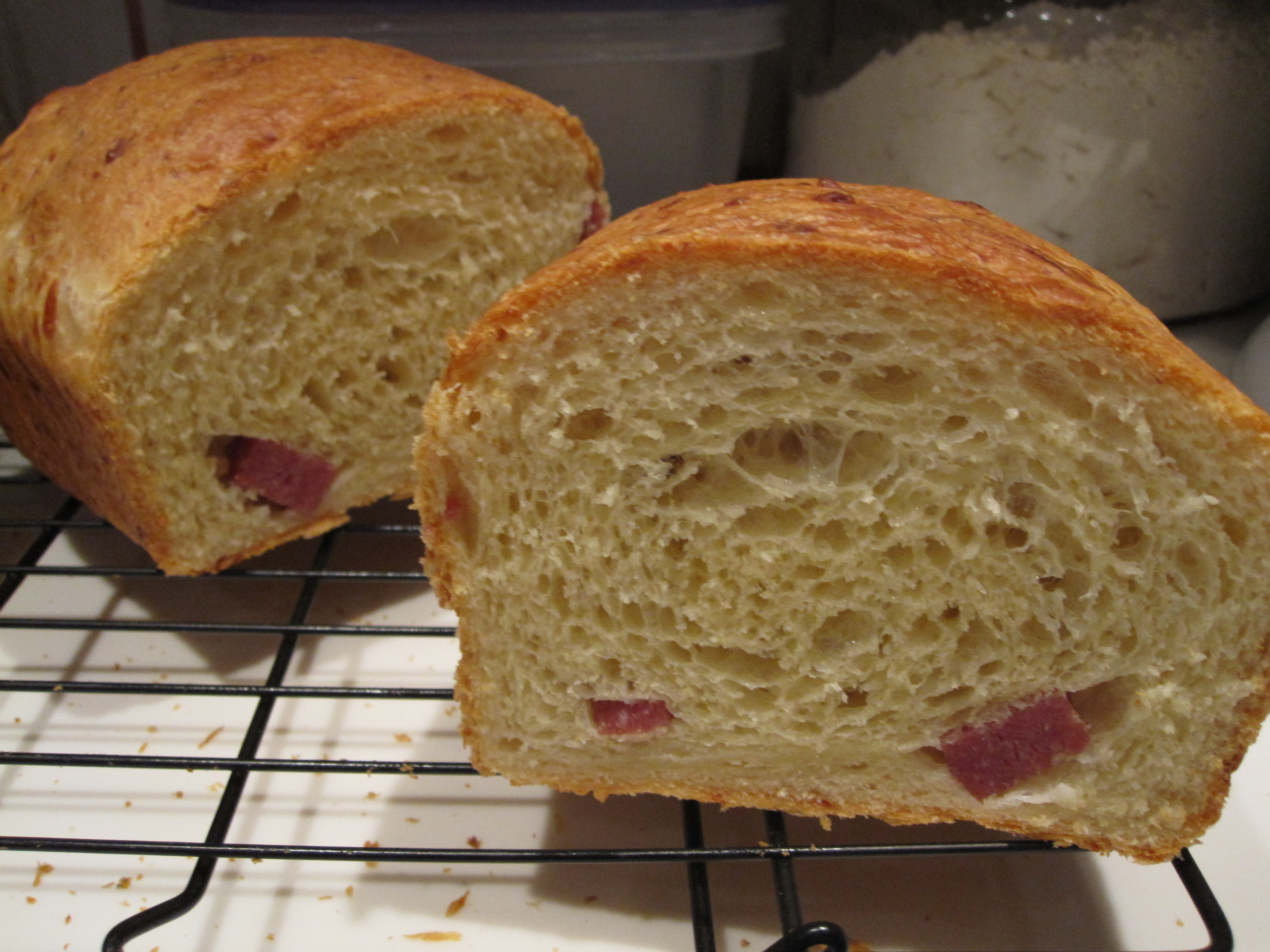Hey guys! Here's my post about Casatiello, an enriched bread with cheese and meat. I'm doing the BBA Challenge for a project in my high school. My brother and I share a blog (he's going to start writing soon) where we document our journey through the Bread Baker's Apprentice. Here's the link: http://bakingacrosscountry.wordpress.com/

Casatiello, a Neapolitan Easter bread, is also known as Tortano in other parts of Italy. The word casatiello is derived from the Neapolitan word for "cheese." Casatiello is enriched bread, much like brioche, with the addition of cured meat and cheeses. Traditionally, Italians add salami and pecorino-romano and/or provolone cheeses.
Like many other breads, casatiello has religious significance. The rising dough represents the resurrection of Christ on Easter. The traditional circular shape represents Christ's crown, and the eggs on top signify His rebirth.
To incorporate the meat and cheese, Reinhart kneads in these additions. However, while researching other recipes, they call for the dough to be rolled out flat, sprinkled with meat and cheese, and rolled up like a sandwich loaf. The traditional casatiello is topped with raw eggs, covered with dough crosses. When baked, the eggs atop the casatiello are similar to hard-boiled eggs. Reinhart bakes his bread in tall mold, like a coffee can, lined with a paper bag. However, many traditional recipes call for the dough being shaped in ring and baked in a tube pan.
In comparison to many of Reinhart's recipes, this bread can be made in one day, rather than retarding overnight. However, he does use a sponge to add more flavor to his bread. I began by mixing flour and yeast, which I added warm milk to. I let this ferment for about an hour, until it collapsed when tapped the bowl.
Meanwhile, I shredded some provolone cheese, and diced some salami. I sautéed the salami for a few minutes, and it rendered some fat and became slightly crispy.
Next, I mixed flour, salt, and sugar in the bowl of my Kitchen Aid. Next, I added eggs and the sponge to the flour mixture, and mixed until it became a ball. After resting a few minutes, (known as autolyse), I added ¾ cup of room temperature butter in 4 additions. The dough was sticky and soft, and I kneaded it for about 5 minutes until it became slightly tacky and smooth.
I sprinkled the meat over the dough, and tried to knead it in the mixer. However, the salami just whizzed around the bowl, so I decided to knead by hand. After the meat was incorporated, I added the cheese, which mixed in much easier than the meat. I let the mixed dough rest for about an hour and a half, for the first rise.
Since I didn't have coffee tins, and I didn't want to stray from Reinhart's recipe, I chose to bake the casatiello in two loaf pans. I shaped it like I would sandwich bread- I flattened it into a rectangle and rolled it into a tight cylinder. Remembering my mishap while shaping the brioche, I made sure to seal these loaves extra tight. After being shaped, I let the dough rise for the final time for about 90 minutes.
The loaves baked in a 350 degree oven until they were golden brown, and the insides reached about 190 degrees. Unlike the brioche, they were not glazed, but the top was speckled with dark bits of cheese.
When I cut into the loaf, I could see the bits of melted cheese, which made this cool, web-like structure in the bread. Maybe because I'm not a fan of cured meats is the reason that I didn't really find this bread to my liking. Although I liked the rich and soft texture of the bread, I didn't like the bits of salami. I probably should have cubed the meat finer, so it was more evenly distributed. I made this bread with my mentor, Mr. Esteban, in mind. He does not like sweet breads and casatiello is the epitome of the savory kind he would enjoy.
Esposito, Mary Ann. "Neapolitan Stuffed Easter Bread/Neopolitan Casatiello." Ciao Italia. PBS, 2011. Web. 18 Jan 2011. <http://www.ciaoitalia.com/>.
Reinhart, Peter. The Bread Baker's Apprentice. 1st ed. . New York, New York: Ten Speed Press, 2001.129-132. Print.






